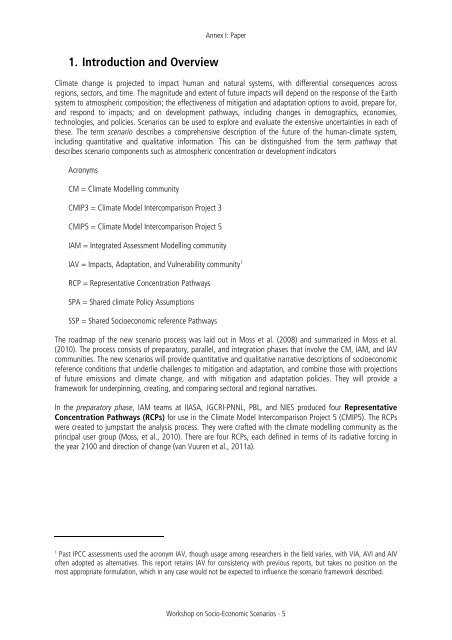Workshop Report - IPCC
Workshop Report - IPCC
Workshop Report - IPCC
You also want an ePaper? Increase the reach of your titles
YUMPU automatically turns print PDFs into web optimized ePapers that Google loves.
Annex I: Paper<br />
1. Introduction and Overview<br />
Climate change is projected to impact human and natural systems, with differential consequences across<br />
regions, sectors, and time. The magnitude and extent of future impacts will depend on the response of the Earth<br />
system to atmospheric composition; the effectiveness of mitigation and adaptation options to avoid, prepare for,<br />
and respond to impacts; and on development pathways, including changes in demographics, economies,<br />
technologies, and policies. Scenarios can be used to explore and evaluate the extensive uncertainties in each of<br />
these. The term scenario describes a comprehensive description of the future of the human-climate system,<br />
including quantitative and qualitative information. This can be distinguished from the term pathway that<br />
describes scenario components such as atmospheric concentration or development indicators<br />
Acronyms<br />
CM = Climate Modelling community<br />
CMIP3 = Climate Model Intercomparison Project 3<br />
CMIP5 = Climate Model Intercomparison Project 5<br />
IAM = Integrated Assessment Modelling community<br />
IAV = Impacts, Adaptation, and Vulnerability community 1<br />
RCP = Representative Concentration Pathways<br />
SPA = Shared climate Policy Assumptions<br />
SSP = Shared Socioeconomic reference Pathways<br />
The roadmap of the new scenario process was laid out in Moss et al. (2008) and summarized in Moss et al.<br />
(2010). The process consists of preparatory, parallel, and integration phases that involve the CM, IAM, and IAV<br />
communities. The new scenarios will provide quantitative and qualitative narrative descriptions of socioeconomic<br />
reference conditions that underlie challenges to mitigation and adaptation, and combine those with projections<br />
of future emissions and climate change, and with mitigation and adaptation policies. They will provide a<br />
framework for underpinning, creating, and comparing sectoral and regional narratives.<br />
In the preparatory phase, IAM teams at IIASA, JGCRI-PNNL, PBL, and NIES produced four Representative<br />
Concentration Pathways (RCPs) for use in the Climate Model Intercomparison Project 5 (CMIP5). The RCPs<br />
were created to jumpstart the analysis process. They were crafted with the climate modelling community as the<br />
principal user group (Moss, et al., 2010). There are four RCPs, each defined in terms of its radiative forcing in<br />
the year 2100 and direction of change (van Vuuren et al., 2011a).<br />
1<br />
Past <strong>IPCC</strong> assessments used the acronym IAV, though usage among researchers in the field varies, with VIA, AVI and AIV<br />
often adopted as alternatives. This report retains IAV for consistency with previous reports, but takes no position on the<br />
most appropriate formulation, which in any case would not be expected to influence the scenario framework described.<br />
<strong>Workshop</strong> on Socio-Economic Scenarios - 5

















